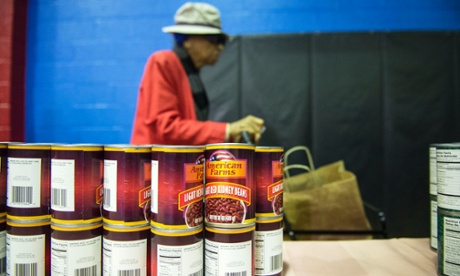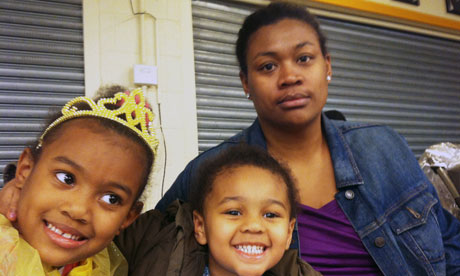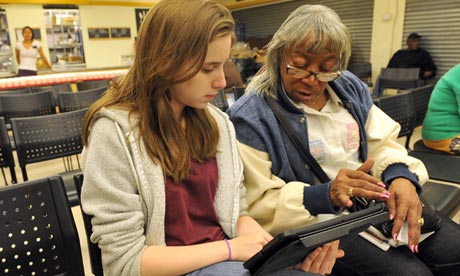Do you know that Russia and China openly talk about attacking the USA? Our so called news media is silent about it. Dumitru Duduman was shown this in the 1980's. First there will come an uprising in the middle of the country. While the government is putting it down, Russia, China, Cuba, etc, will attack.
People, please get right with God. Very difficult times are ahead. You cannot trust man, but if you place your trust in Jesus the Messiah and obey him, the worst thing that can happen is the death of our bodies and we will go to where Jesus is. If we do not, we will go to hell. Jesus paid the only price there is for sin. If we reject Him, he has to separate the wicked from those who have received his cleansing from sin.
If I can reach one person for Christ. If I can reach one person and free them from false teachers such as Joel Osteen whose teachings are from hell. It would be worth all the countless hours I have put into my blog posts......
US emergency food providers brace as $5bn food stamp cuts set in
Snap funds expire Friday, leading to cuts in the food stamps programme that will affect every US household that depends on it
• Help us report on America's food banks
• Help us report on America's food banks

Inside a three-storey yellow brick building in East Harlem, at the north-east corner of Central Park, a brisk operation is under way to put food on the tables of some of the most needy families in the US. Clients place orders in a waiting room in the basement, or online from home, reducing the need for long lines in the cold. One floor up, scores of volunteers pack shopping bags from giant tubs of fresh fruit, vegetables and other foodstuffs. When an order is ready, smiling schoolgirls call the names of clients and hand over the goods.
New York Common Pantry (NYCP), the city's largest single-site emergency food provider, served 25% more people in the past three months than in the same period last year. It has 200 volunteers each week to serve 38,000 individuals. Staff fear the worst is yet to come.
"It's a very, very difficult time," says Stephen Grimaldi, the executive director of NYCP. For months, charities and food activists have warned that when stimulus funds expire on Friday, leading to cuts in the food stamps programme, it will affect every US household that depends on it. Pantries, soup kitchens and other crisis providers will bear the brunt.
"We're bracing ourselves,” says Grimaldi. “We certainly know that we are going to see another increase in numbers by the end of the month."
Grimaldi is not alone. Other emergency food providers in the US are preparing for an influx of struggling families across the country who have been warned their Supplemental Nutritional Assistance Program, or Snap benefits, will be cut on Friday. Feeding America, the hunger relief charity, describes the scale of the cuts, $5bn a year, as representing about 2 billion meals a year and warns that the effect will be "close to catastrophic".
The cuts are the result of the expiry of the fiscal stimulus legislation of 2009, which increased Snap benefits to provide a spur to the economy. The cuts will be unprecedented in depth and breadth, according to a report by the Center on Budget and Policy Priorities (CBPP), a non-profit thinktank, and they will happen automatically, affecting every household in the US which qualifies for Snap. The US Department of Agriculture estimate there are 47 million people on food stamps, a number that includes 22 million children and 9 million people who are elderly or have a serious disability, according to a recent report by the CBPP. There are 1.9 million people on Snap benefits in New York alone.
Food charities and activists are concerned that food stamps are already not enough to live on and that the cuts – the equivalent of taking away 21 meals a month for a family of four – will significantly increase the number of households going hungry. "What we traditionally see is food stamps are never enough to get through an entire month," says Grimaldi, citing the cost of living in New York. “It will exacerbate what people are already experiencing.”
On Thursday, the day the Guardian visited, many of those waiting in the line outside the NYCP, which snaked its way down the stairs to the waiting room in the basement, were elderly, supported by walkers or canes. One woman was in a motorised wheelchair. Others pushed strollers.
Among those in the waiting room was Carmen Centeno, with three of her five daughters: Jayne, Mya and Anastasia, who is eight months old. It was her first visit to a food pantry this year, she said.
'I live in Manhattan and food is expensive. It's crazy'

Centeno, 32, who lives in the west side of the city, has been on food stamps and other public assistance since a back injury stopped her working for the parks department four years ago. The public assistance she receives amounts to $400 a month, $200 of which goes towards her subsidised rent, $50 to her energy bill, $20 to cleaning products and the rest on children's clothes and other necessities. She usually gets $589 in Snap benefits; she is now expecting to get around $36 less.
"When the food runs out I usually ask my family for help,” she said. “It's hard to make ends meet. I get tired of asking them and they are having trouble too. I live in Manhattan and food is expensive. It's crazy."
She said the kids want "cakes and chips and junk" but she no longer buys such unhealthy luxuries. With the cut, she will swap the red meat she buys once in a while for chicken, which is cheaper. She will also cut out fruit juice. And she will come back to the food bank when necessary, she said.
Another client, Araceli Moran, 41, a mother of two from White Plains, works one day a week making tamales at a market. She said she has been looking for a better job for three years, the same length of time she has been coming to the food bank. Her husband, Nicholas, makes $250 a week preparing food in a restaurant. She only makes $25 in a day at the market, but it is better than nothing, she said. They receive Snap benefits of $360 a month, which will be cut by $20. It doesn't seem a lot, Moran, originally from Mexico, said, but that could buy "a large bag of rice or olive oil for cooking".
Staff at the NYCP say that, based on anecdotal evidence, around 30% to 40% of their clients are low-paid workers.
Food charities and those operating emergency food supplies say they are doing everything they can to prepare for the Snap cuts, from asking for more donations to spending more money, if they have it, on food, to increasing their “food rescue” operations from bakeries and retailers and by reaching out to foundations and corporations.
Charles Meng, executive director of Arlington Food Assistance Center in Virginia, says he expects that by the end of the year, the number of his clients would rise to the level seen at the height of the recession. "There is a seasonality to the numbers of people,” he said. “A lot of families rely on part-time and seasonal jobs to supplement their income. We had 1,500 in the summer and 1,600 now.”
'Every time the government steps away, we step in'

Triada Stampas, the senior director of government relations at the Food Bank for New York City, the largest food bank in the US, which provides food to a network of emergency food providers, says the cuts would take away 76 million meals in New York City alone – the exact number of meals distributed by her organisation.
“We would need to double our output to make up for it,” says Stampas, who expects the demand driven by the cuts to be so high that the food bank may be forced to ration its supplies. “The decision to turn a person away, to shut the door while there is still a line, is not a decision taken easily. But we may see rationing, perhaps smaller meals.
“There is a real risk of hunger growing in our city and across the nation and of people going without and that's a scary, scary thing.”
Grimaldi says he doesn’t plan to introduce rationing yet. The NYCP has already reduced the number of meals it provides, from nine a week a few years ago to 12 every two weeks today. He will look to bring in more revenue, increase rescued food and put in more applications to foundations.
“Every time there's a cut and the government steps away, we step in,” he says. “We will do everything we can.”
• This article was amended on Monday 4 November to clarify that New York Common Pantry has about 200 volunteers each week, and about 12,000 in total. This has now been changed.
No comments:
Post a Comment